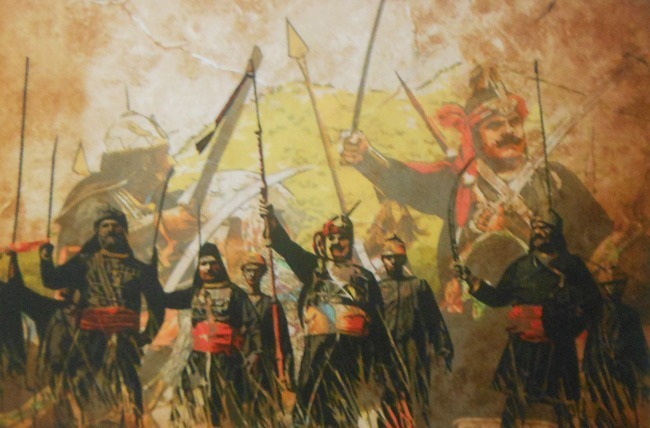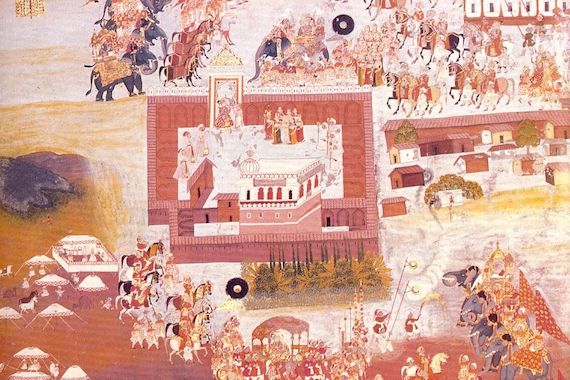By Smita Mukerji

Read the previous section of this series here.
“Partáp, with the flower of Mewár, defended the head of the pass,
and glorious was the struggle for its maintenance.
Clan after clan followed one another with desperate intrepidity,
emulating the daring of their prince, who led the crimson banner”[1]
O U T C O M E
The mootable question about the Battle of Haldighati, contested all the more in the polarised discourse today, is: which side was worsted and which won.
By most contemporary Mughal accounts, the total casualties from both sides numbered about 650[2], of which 150 were those slain from the Mughal army and the remaining were Rajputs.[3] The number of wounded in the imperial army was over 300.
After the Rana’s exit from the battlefield, the Mughals did not pursue the withdrawing Rajputs, exhausted as they were from the incessant fighting in the sweltering heat. Moreover, thoroughly rattled by their encounter they were in dread of ambuscades from the Rajputs concealed in the defiles.[4] Rajput sources[5] state that the Bhils kept up the Mewari resistance on that day conducting black-mail till night depriving the Mughals of the provisions they had stored.
Though the loss of life was greater for the Mewari army, psychologically the Mughals appear to have sustained greater damage from the unexpected reverse. It is quite clear from their edgy behaviour that they did not see the result as a victory for themselves. The Persian chronicles, especially Muntakhab-ut-Tawarikh, testify that there was no rejoicing in the Mughal camp after their avowed “victory”. As jumpy as hares they were stricken with panic in anticipation of a possible Mewari strike.
Man Singh was in a quandary as to how to save face at the miserable failure in achieving the goals he had set out for: to capture the Rana and secure the capitulation of Mewar to the Mughal crown. He therefore attempted to snatch whatever advantage he could from the Mughals’ slim gain in the battle. He dared not pursue the Rana to the neighbouring mountains since that would have been akin to stepping into the tiger’s lair, forcing a skirmish on a ground of the adversary’s choice. Instead, after looking to the wounded and resting his troops for a day, on June 20[6] he arrayed them in military formation and prepared to occupy Gogunda, which had already been deserted by the Mewaris. About one score warriors under the priest Shri Chand, who had stayed behind voluntarily to defend the place, engaged the imperialists in a spirited stand off[7] before succumbing and being mercilessly massacred to the last man.
But gaining this position did not significantly allay the frayed nerves of the Mughals. Apprehending sudden attacks from the lurking Mewaris,[8] they proceeded to elaborately barricade the position by building a wall and trench around the city, cooped up and in want of basic provisions, though no besieging enemy was visible. The barren nearby districts made the occupation extremely troublesome. Having lain waste the countryside, the Rana now prevented further supplies from reaching the plains.[9]

The Mughals fretted with the difficulty of maintaining the commissariat, forced to live on the little that their scroungings in the vicinity yielded: meat from a couple of herds driven by them and on mangoes that were plentiful in the area. But consuming too many mangoes soon led to many among the men falling sick and being incapacitated.[10] Soon even these bare supplies ran out. Their ventures to procure food led to scuffles with the Rana’s bands ranging the surrounding area and Mughal losses in those compelled Man Singh to forbid even this means of rationing his troops.[11] Mughal annalists[12] affirm that Man Singh would not order foraging detachments for fear of attacks by the Rana’s parties waylaying the route connecting Gogunda to the imperial lines and apparently he incurred the Emperor’s wrath on account of this. Both he and Asaf Khan were forbidden to appear in his audience for a few days,[13] vexed as he was at their inability to hunt down the Rana and eliminate him and not plundering his territory. The Mughals had patently not succeeded the slightest bit in diminishing the Rana’s power. Nevertheless this did not prevent them from claiming victory for themselves.

The nobles at this time urged Man Singh to send a report to the Emperor with suitable tokens declaring their success in the battle. Badayuni’s name was put forth by Asaf Khan as ideally suited to be the bearer of the good news as ‘he had been allowed to join in the battle purely for acquiring religious merit.’[14] After some bantering on this point between Man Singh and Badayuni, who was anxious to be on his way now, he was finally allowed by the former to be the conveyor. He was despatched after being furnished with appropriate letters of commendation along with the prized elephant Ramprashad which was to be presented as trophy to the Emperor. Though Abul Fazl in his characteristic manner of overstatement adds “splendid articles of booty” to the winnings sent along with the messenger, he does not specify what these were, and nor do any of the other Mughal chroniclers mention any spoils. Apparently, the elephant which had been captured by providence was the sole taking for the Mughals won from this hard-fought battle.
So great was the Mughals’ trepidation of the Rana that a force of 300 cavalry was detailed as Badayuni’s escort and Man Singh himself accompanied the train for 32 miles before returning to Gogunda. Badayuni provides another interesting anecdote. At the places that his entourage passed on the way to Fatehpur, the circumstances of the battle were published, but the claim of Mughals’ triumph were scoffed at and dismissed by the inhabitants. Clearly the depiction in Mughal chronicles of Akbar being the acknowledged overlord of India and those who challenged his authority painted as ‘rebels’ was not universally accepted. In the hearts of the people of Rajputana, the Rana reigned supreme and inspired implicit faith in his generalship.
Rajput sources[15] also give exaggerated accounts of their own victory in the battle which carry limited merit given their retreat and the significant loss of Mewari chiefs and men. But it is apparent from the mood in the Mewari camp that for them the setback in the battle was neither permanent nor debilitating. They had against heavy adversity dealt a blow to the morale and prestige of the greatest empire of that time. They had all but won the battle and inflicted considerable damage in return. To their credit, all the Persian accounts are neutral in describing the war scene, and though they denounce the Rana as a reprobate, eulogise equally the valour and feats of the combatants on both sides.
The Rana safely made it from Haldighati to Koliyari[16], and collecting his shattered troops, the Mewaris formed themselves in Mojera[17], a village in the hills west of Gogunda. To have their beloved leader alive with them was sufficient to keep the men buoyed up and determined not to let the enemy intrude any further. For Maharana Pratap, the battle was a pivotal event which gave him confidence and fresh resolve to continue on the idealistic but until then untried path he had determined for himself. “The lessons of Haldighati became responsible for a change in character of warfare between Pratap and Akbar.”[18]
Two copper plates[19] recovered from the villages Mohi and nearby Pipli, granting the villages Pipli and Sathana in Central Mewar to one Balabhadra, corroborate the fact that the Rana had revived his authority in the area and was stationing his chiefs strategically to check the influence of the Mughals. Considering that the date of the inscriptions is close after the battle (August-September 1576) and the proximity of these places to Haldigahti (all three being in Rajsamand) it is plausible that the Rana was de facto in control of the area.
The monsoon soon set in, and around this time on September 27, 1576, Man Singh and Asaf Khan left Gogunda, summoned to the imperial presence in Ajmer, where the Emperor had arrived after settling disturbances in Bengal.[20] The Rana moved swiftly and expelling the Mughal commanders at the post, reoccupied Gogunda and Mohi, barely three months after the Battle of Haldighati. And with this, any fruit gathered by the Mughals from the momentous clash was neutralised.
If assessed in terms of the competing objectives, the Battle of Haldighati can indeed be regarded as a Mewari triumph, because the Rana had successfully defended his territory and the Mughal invasion had been a miserable failure. It would not be improper to describe the outcome as a tactical withdrawal by the Rana after a swift but intense engagement that rendered the enemy ineffectual. In spite of the high casualty it was no decisive defeat for them, and for the Mughals, certainly no victory.
For Akbar it became clear that the time for trifling had passed. Where Man Singh and Asaf Khan, the architects of many a Mughal victory, had failed, no other general could be expected to succeed. The emperor had to move now himself to meet the challenge to the imperial might from Mewar’s defiance. What he had intended, with the massive deployment in Haldighati, to be a single, conclusive collision, turned out to be in fact an epic struggle, the meeting of the aggrandising ambition of arguably the most powerful potentate of the world at that time, and the singular determination, indomitable courage and endurance of the bearer of an ancient, noble lineage, to preserve his freedom, dignity and honour.
We shall trace this protracted war and its significance for the history of our land in the next installment of this series.
Cover Picture
Artist image of Rana Pratap and his men (Source: Udaipur Times)
[1] ‘Annals and Antiquities of Rajasthan’ – I, James Tod
[2] This figure is confirmed by Mutamid Khan Bakshi (Iqbalnama-i-Jahangiri, Vol. II) and Khwajah Nizamuddin Ahmad (Tabakat-i-Akbari, Vol. II). According to Badayuni (Muntakhab-ut-Tawarikh, Vol. II) the total number of casualties was 500, of which 120 was the number of men killed from the imperial army.
[3] Rajput accounts cannot be relied upon as they inflate the strength of combatants as well as the casualties on both sides to impossible numbers: that of the Mewaris given as 20,000 and of the Mughals as “beyond counting”. (“विखंडितानां यवनेश्वरस्य महाभटानां गणनां विधातुं । विद्या विनोदी गणेश्वरोपिशाक्तोन कोन्यः प्रभवेत्समर्थः ॥” – Amarkavya Vanshavali, Folio 44a.; Rawal Ranaji ki Vat, Folio 107a.)
[4] “When the air was like a furnace, and no power of movement was left in the soldiers, the idea became prevalent, that the Rana, by stealth and stratagem, must have kept himself concealed behind the mountains. This was the reason why they made no pursuit, but retired to their tents…” – ‘Muntakhab-ut-Tawarikh’, Badayuni
“On account of the excessive heat and the fatigue of the battle the imperialists did not set their hearts on pursuing the enemy.” – Akbarnama III, Abu’l-Fazl
[5] “आस्त सूर्योदयतः प्रभूते सूर्यास्त कालावधि धन्य युद्धे रणेशहः” (MS. Amarkavya Vanshavali, F. 44b.)
“सर्वं कुटिस्थ मपहाय धनं विहस्ता’ ‘अरि भवना त्ग्रीहित वित्तः’” (MS. Raj Ratnakar, Canto 7, V. 41-2)
(Quoted in ‘Mewar and the Mughals’, G. N. Sharma)
[6] June 23rd by some accounts
[7] This farce of an engagement was in keeping with the ancient custom of the Rajputs that when compelled to evacuate a city, they should be killed to the last man in order to preserve their honour. (Badayuni, MuT-I, p. 234)
[8] “The Amīrs, as security against a night attack on the part of the Rāna, barricaded the streets and drew a trench and a wall of such a height that horsemen could not leap over it, round the city of Kokundah and settled down quietly.” (MuT-I, p. 240)
[9] Ibid. p. 241 (“..the Banjaras did not come..”)
[10] Ibid. (“The common soldiers used to make a meal on it, fasting, in default of bread, and from its extreme juiciness very many of them became ill.”)
[11] Ibid. (“..from time to time they singled out one of the Amirs in command, and commissioned him to bring corn into the lines, and whenever in the high hills and mountains they found many people congregated together, they broke them up and took them prisoners.”)
[12] “At this time it was brought to the notice [of the Emperor], that owing to the narrowness (and difficulties) of the roads, very little grain arrived and there was great scarcity among the troops. Kunar Man Singh had also prohibited his men from plundering and devastating Kika’s country. Owing to this there was great privation among the troops.” (Tabakat-i-Akbari)
[13] “His Majesty, on hearing these matters, issued a farman for summoning Kunar Man Singh. He came and waited [on the Emperor]; and was for some days forbidden to appear in the presence.” (Tabakat-i-Akbari)
“The Emperor sent for Mān Singh, Āҫaf Khān and Qāzī Khān, to come alone from that place, and on account of certain faults which they had committed, he excluded Mān Singh and Āҫaf Khān (who were associated in treachery) for some time from the court; while on the contrary Ghāzi Khān Badakshī, and Mihtar Khān, and Alī Murād Uzbek, Khanjarī Turk, and one or two others, of whom I was of the number, were distinguished from these men, and were honoured with presents and promotion in rank. But all the rest, though they fell from position of confidence, were dismissed without punishment.” (Muntakhab-ut-Tawarikh II)
(also corroborated in Tarikh-i-Nizami and Akbarnama)
[14] “And when the author … arrived at about the cosses from Ajmīr, and ardour for fighting against the infidels kindled in my breast, I returned and represented the state of the case to the high ҫadr … and made interest with him to obtain leave of absence from the Emperor.” Badayuni (MuT-I)
[15] Raj Prashasti VI, Pg 31; Raj Prakash (MS) Lf 21.
“कृत्वा करे खंखालता, स्व वल्लभां प्रतापसिंहे समुपागते प्रगे ।
सा खंडिता मानवती द्विषच्चमूह संकोचयन्ती चरणौ परांगमुखी ।।” (Jagdish Temple inscription)
[16] Viravinod, Rajprashasti, Vanshabhaskar, Amarkavya (f. 85b)
[17] Viravinod, p. 141
Udaipur (MS.), f. 43a.
[18] A. L. Shrivastava
[19] “महाराजाधिराज महाराणा श्री प्रतापस्यंघ आदेशात ग्राम मही म्हे रहंट ३ उदक आधाट कीधा संवत् १६३३ वर्षे आसोज बदि ६ कुंभलमेर मध्ये” [Mohi plate]
“महाराजाधिराज महाराणा श्री प्रतापस्यंघ आदेशात ग्राम पीपली मया [कीधौ] उदके आघाटे दता कुंभलमेर मध्ये संवत् १६३३ वर्षे भादवा सुदि ११” [Pilpi plate]
(Source: ‘History of Mewar’, R. V. Somani)
[20] He had received news of the privations suffered by the Mughal camp and his ears had also been poisoned especially in respect of Man Singh that he had been less than industrious in the pursuit and extirpation of the Rana on account of partiality towards one of his tribe. Akbar’s misgivings later dispelled, Man Singh and Asaf Khan were freed from their abomination after biding several days and restored in the Emperor’s graces. (See footnote 13)

Keep up the good work. Eagerly waiting for the next part of the series.
Thank you so much! You can follow us on Facebook/Twitter for updates on further parts of this series and other articles on history . Do read the previous installments of this series too.
Fantastic writeup. Eagerly awaiting the next series.